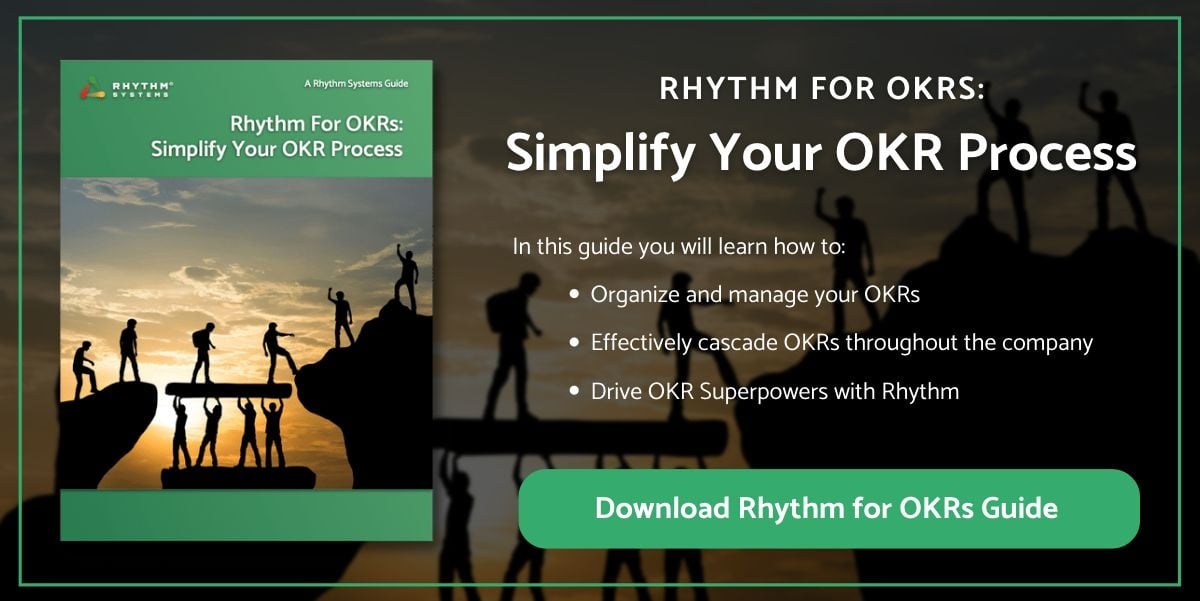Businesses looking to implement goal-setting  best practices are often drowning in a sea of acronyms that can be hard to navigate. What’s better - MBOs or OKRs? Where do KPIs fit in? Should I have SMART goals or stretch goals, or something else? There are lots of tools and frameworks and different acronyms out there, but there are some key elements of effective goal-setting that underlie all of the most effective business and performance management goals.
best practices are often drowning in a sea of acronyms that can be hard to navigate. What’s better - MBOs or OKRs? Where do KPIs fit in? Should I have SMART goals or stretch goals, or something else? There are lots of tools and frameworks and different acronyms out there, but there are some key elements of effective goal-setting that underlie all of the most effective business and performance management goals.
First, let’s clarify the terminology a little bit. I’ll give a brief explanation of what MBOs, OKRs, and KPIs are and what the pros and cons may be for each.
MBOs: Management by Objectives
Recently, many new Rhythm clients have come to us with their MBOs, which stand for Management by Objectives. This is an old-school management framework originally outlined by Peter Drucker in 1954 that seems to be making a comeback of sorts as companies set objectives for success.
Pros:
Clarity between a manager and a direct report around expectations and how that will impact compensation is highly desirable. People like knowing what their performance is being judged on - they like knowing the targets and what it will take to win.
Cons:
In his book, Measure What Matters, John Doerr outlines a few key areas where MBOs may fall short. They are typically only set on the annual time horizon, which in today’s fast-moving world can be impractical as things change quarterly, monthly, or even more frequently in many industries. They set a clear “what” without a well-defined “how.” They tend to be private, siloed, and tied to compensation. They are generally pushed top-down rather than set collaboratively, and they can encourage contributors to be more risk-averse.
In his HBR Article “Management by Whose Objectives,” Harry Levinson explains that traditional MBOs have many problems, like potentially stifling innovation or motivating employees to focus too much on the numbers at the expense of the bigger strategic picture (think the Wells Fargo account scandal). This traditional approach leaves out human components - like personal goals and strengths outside the compensation structure - that can be more motivating.
OKRs: Objectives and Key Results
Another goal-setting framework that has become increasingly popular is OKRs, which stands for Objectives and Key Results. This is a collaborative process popularized by companies like Google and Intel but has been adopted by companies of all sizes and in all industries. Visual learner? Check out our OKR Explained Video.
Pros:
Rather than being top-down like MBOs, OKRs are more collaborative and transparent. The Objective, like an MBO, outlines what needs to be done, and the Key Results get into the how so many people find this method more helpful for execution.
The time horizon on OKRs is more fluid (not always annual), and they typically are not directly tied to compensation in the same way. The transparent and public nature of OKRs makes it easier to align and cascade goals throughout the organization and eliminate some of the silos that can happen when goals are created in isolation.
Cons:
The relationship between OKRs can be difficult to visualize and understand in practice - especially as your company grows, it can be hard to effectively communicate and focus on a few top things collectively. When goals are set from the bottom up, it can also be hard to get buy-in at the top for some of the work being done. It can also be a heavy lift to implement OKRs because it requires a high level of commitment and discipline as well as an investment in training and set-up time upfront. This blog article provides a more detailed look at OKRs vs. KPIs.
KPIs: Key Performance Indicators
Key Performance Indicators are the handful of numbers most important for measuring your company’s (or your team’s) health. They can be result indicators or leading indicators, which let you know if you are on track to achieving those results.
Pros:
KPIs are more targets than goals, but when used in combination with Priorities or Annual Initiatives, they will help you focus on the few things that are most important in your business - the numbers that matter to ensure your success over time.
They are the measure of whether you are successful in achieving the big goals for your business - think revenue, profit, customer satisfaction, employee health. They can keep you honest - if you have achieved all your goals for your quarter, but your KPIs are Red, you probably didn’t pick the right goals.
Cons:
The temptation with KPIs (like any goals) is to set too many. Looking at too many KPIs will make your eyes cross and prevent you from acting to move the numbers in the right direction. Also, looking at KPIs in isolation is a mistake - they should be paired with specific actions or goals for how you are going to achieve those numbers.
Now that we have level set on the lingo… I’ll say that any of the goal-setting tools above can be highly effective if you use them well.
Here’s what the best types of business goals and objectives have in common:
- Clear and Specific. When you write your goal, make it as clear and specific as possible so anyone reading it will know what you mean (regardless of whether they are on your team, in your company, or in your industry). Always include a verb so what you are doing is clear.
- Time-bound. Goals need a clearly defined time frame. You have to set a start and end date. The most common are set for tracking a month, quarter, or annual performance. No matter what time box you use, make sure that you check in regularly to make the appropriate adjustments to meet the company objectives.
- Owned. Even goals that are collaborative should have one clear owner. You need one person who is ultimately accountable for delivering the desired result, who can rally the team, make decisions when adjustments are needed, and keep the goal moving forward. We always say, “If everyone owns it, nobody owns it.” Make sure one person is the owner of each goal.
- Measurable. When possible, put a number on the goal. If the goal isn’t number-driven, describe the successful outcome in a way that is easy to say if success is achieved (or not). Brené Brown says, “Paint done for me” in her book, Dare to Lead, and that resonates. You need to know what successfully completing the goal actually looks like. We use Red-Yellow-Green success criteria for our goals in Rhythm, and we also define failure and a stretch goal, or SuperGreen.
- Shared. Writing down and sharing your goals will increase your accountability to achieving them, and sharing your goals with others is the only way to ensure your company is moving in the same direction. Avoid frustration and rework by communicating the company’s goals clearly and creating a shared dashboard where everyone can link their individual employee goals to the company’s goals.
- Focused. Covey’s work teaches us that we are most effective when we focus on only a few goals at a time. More than 3-5 goals is too many - you won’t achieve success. Prioritize your goals, and keep your list short.
- Connected. Your goals are most meaningful when they are connected to the bigger picture - the longer-term strategy for your company. Choose goals that align with your company’s strategy, mission, vision, and values.
- Supported. You need to be sure that you are allocating resources to support your goals. Set your teams up for success by ensuring the goals are achievable and that they have the right skills, energy, people, and budget to make it happen.
- Celebrated - or learned from. When the goal’s end date comes around, don’t just move on to the next goal on the list. Take the time to learn the lessons from goals that didn’t go as planned, and celebrate success when you do achieve the results you set out to achieve. This can take place during a performance review or when a major milestone is reached.
- Management Review. These should be reviewed by the manager, and the personnel held accountable for the deliverables. This is a great time to make adjustments that might be needed to hit your targets and a good place to provide the coaching needed to drive peak performance and team accountability.
Regardless of which goal-setting framework you choose, our Rhythm strategic management software platform will help you drive success, and the cloud software supports all of these goal types. After all, setting goals is only the first step - then you have to do the work! Rhythm’s habits and tools will give you visibility into progress, help you have the right conversations, drive collaboration for cross-functional goals, and give you the tools you need to see goals through. We’d love to show you how our software can help you achieve your dreams and goals.
How can a manager set MBO KPIs?
A manager can use the objectives outlined in their MBOs to create effective KPIs to keep track of the progress of the objective, thus creating an MBO KPI. What can be measured? Are there any leading indicators that you can use to adjust early in the process? Visit our comprehensive list of balanced scorecard KPIs that might help get you started in measuring for success. Read our manager's guide for goal setting for more information.
Looking for some additional OKR examples to help get you started?
OKR vs KPI: What’s the Difference Between OKRs and KPIs and Why You Need Both?
OKR Spreadsheets: Why You Should Upgrade Your OKR Software Game
Using OKRs for Your Weekly Team Meeting
OKR Video: How to Get Started with OKRs and the Best OKR Software
OKR Examples for Manufacturing: Measure What Matters for the Quarter
Using Red Yellow Green Performance Indicators Examples That Are SMART
OKR Goal Setting Steps: 5 Keys to Drive Better Results
SMART Goal Setting Theory: To Create SMART Goals, Start With “Why”
A Manager's Guide to Goal Setting
Photo Credit: iStock by Getty Images






